Scrub Jays
From one species to four
(Listen to the radio version here.)
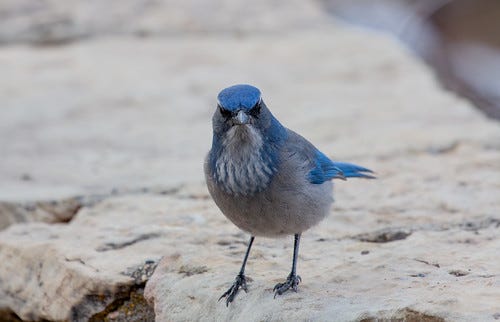
Although many jays are blue, only one species is called the Blue Jay. Scrub jays are only distantly related to Blue Jays, though their intelligence and ability to find caches of food are equally keen. All jays are opportunistic, but scrub jays approach large mammals, including humans, much more readily than do crows or Blue Jays.
On March 29, 1982, when our first baby was just shy of 6 months old, we took a family road trip. Russ had a meeting in Las Vegas, and on the way there, somewhere just past Nephi, Utah, I saw my lifer Scrub-Jay. I saw more in Nevada two days later when a wonderful Las Vegas birder named Marian Cressman took me and baby Joey all around the area for a magnificent day’s birding.
On May 29, 1994, I spent a morning in Griffith Park in Los Angeles. At lunch I parked myself on a bench and suddenly a homeless man I’d not noticed who had been lying down on a nearby bench sat up. He didn’t say a word but looked so hungrily at my sandwich that of course I broke it in half. He took a big bite just as a scrub jay flew in at his feet; he broke off a chunk to share with the bird. When a second jay flew in toward him, I whistled and gave that one part of my sandwich—otherwise I’m sure that poor hungry man would have had an even smaller lunch. Now I’d seen Scrub Jays in three states and was also reinforced in my belief that people who know hunger and want themselves notice and do more than their share to alleviate someone else’s hunger—even a bird’s.
For many years, taxonomists considered all scrub jays in the United States to belong to the same species (Aphelocoma coerulescens), but with the 7th edition of the AOU Checklist in 1998, they split off two scrub jays with disjunct ranges from the main one, re-naming the species in the Channel Islands the Island Scrub-Jay and the one found only in Florida the Florida Scrub-Jay. That meant they had to add a modifier to the name of the remaining population, which became the Western Scrub-Jay until 2016, when it was split into Woodhouse’s Scrub-Jay—the one I saw in Utah and Nevada—and the California Scrub-Jay—the one I saw in Griffith Park.
The Florida Scrub-Jay is the first one European settlers noticed and assigned a scientific name to (Aphelocoma coerulescens), so when all the scrub jays were considered a single species, that’s the name they all shared; now that name belongs only to the Florida species. This is the only scrub jay who breeds cooperatively, the young of previous years helping their parents raise their current brood.
The Island Scrub-Jay, isolated on Santa Cruz Island in the Channel Islands for centuries or even millennia (with a report from Santa Rosa Island from 1892 and fossil records from San Miguel Island), was believed to be a separate species of scrub jay when Henry Henshaw collected four in 1875. These birds were about 15 percent larger, 40 percent heavier, had a bill about 20 percent longer, and were more intensely colored than scrub jays on the mainland, so he concluded they belonged to a separate species and assigned them the scientific name Aphelocoma insularis. By the 5th edition of the AOU Checklist in 1957, ornithologists had lumped it with the other U.S. scrub jays, but as with so many things, if you wait long enough, things go back to what they used to be.
I saw my first Island Scrub-Jay in 2005 on a post-convention field trip after an American Ornithologists’ Union convention in Santa Barbara. We arrived at the Santa Cruz Island Reserve research station an hour or so before sunset. A researcher grabbed and noisily shook a container of peanuts, and instantly, in flew the jays. One by one, they carried off the peanuts to cache away and quickly came back for more. I didn’t have much of a camera at the time but was thrilled with my closeups of this lifer.
I’ve only been to Santa Cruz Island one other time, on December 20, 2013, near the end of my Big Year. I took the Island Packers boat trip out of the Santa Barbara Channel, and then went on a guided tour along some trails at Prisoner’s Harbor. This time the Island Scrub-Jays kept their distance but did allow at least a few distant photos.
For a long time, scientists believed that the Island Scrub-Jay was widely distributed on Santa Cruz Island and had a population of about 12,500. Then in 2012, Smithsonian Conservation Biology Institute scientists and their collaborators determined, after studying how much usable scrub-jay habitat there actually was, that the true number was less than a fifth of that. Now the number is believed to be even lower—Partners in Flight sets this species’ entire population at just 1,700. It’s not listed on the Endangered Species List as either Threatened or Endangered, but its tiny population is at least holding steady. A lot has been done to improve the Island Scrub-Jay’s prospects into the future, including removal of non-native sheep, pigs, and cows that destroy scrub habitat on the island.
In his lovely poem Birches, Robert Frost wrote:
Earth’s the right place for love:
I don’t know where it's likely to go better.
Earth is also the right place for scrub jays. We overpopulated humans, the dominant species on this planet, have an obligation to protect them.




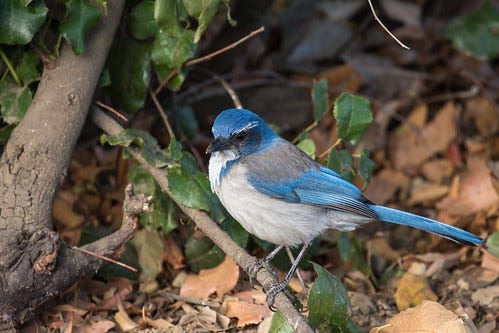
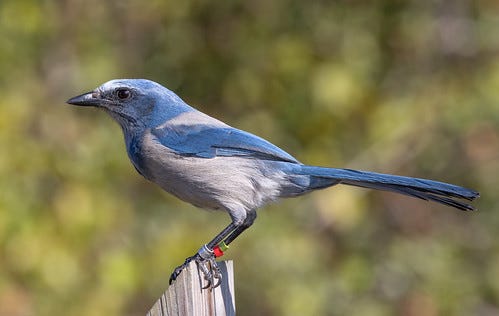

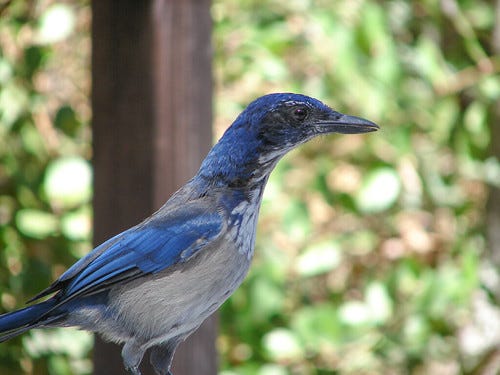
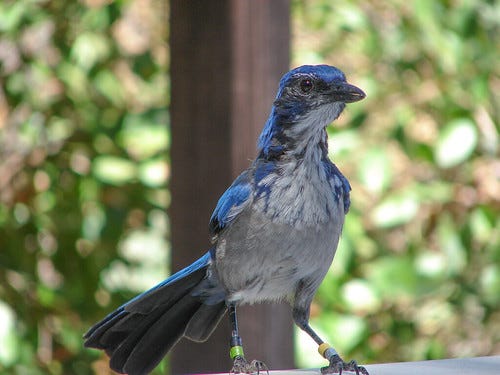
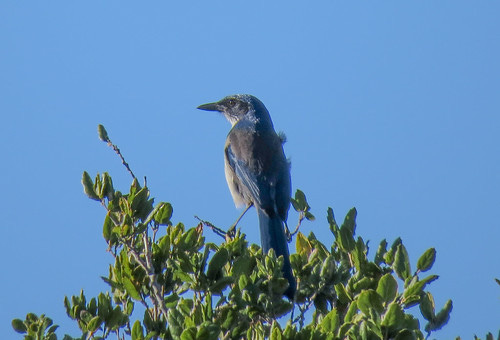
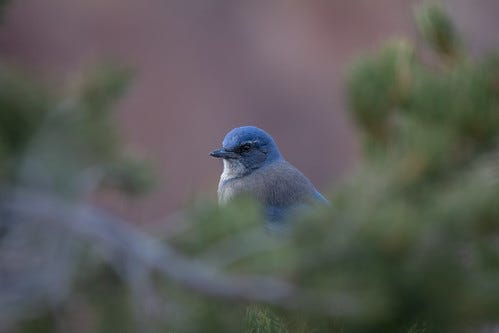
We have a scrub jay who visits our birdfeeder daily. We have knicknamed him “Fatty” because he is so large - and he pushes the other birds from the feeder on approach. Lots of them here in California.